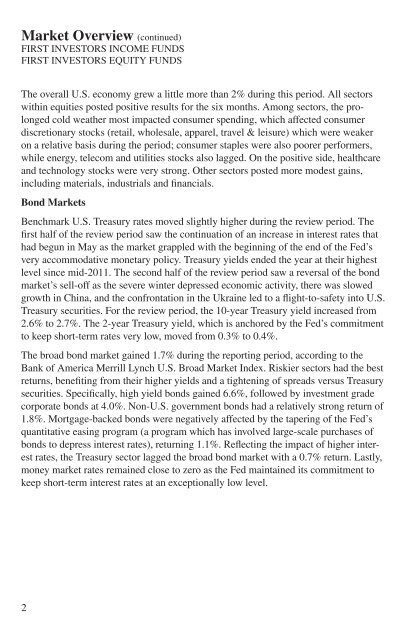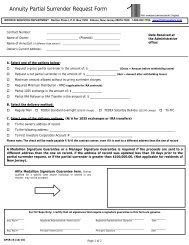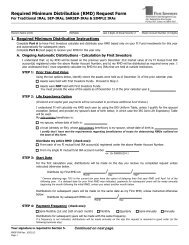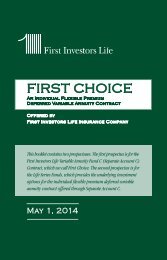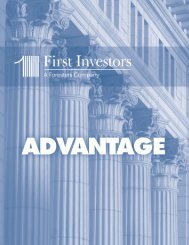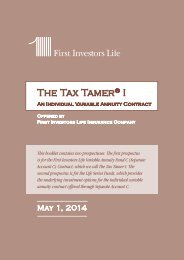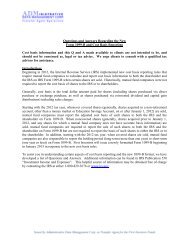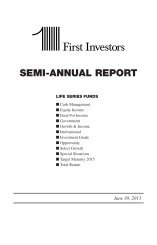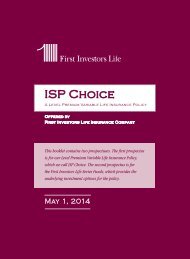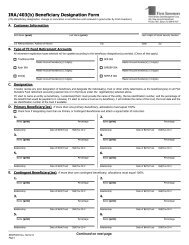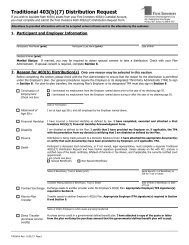SEMI-ANNUAL REPORT - First Investors
SEMI-ANNUAL REPORT - First Investors
SEMI-ANNUAL REPORT - First Investors
Create successful ePaper yourself
Turn your PDF publications into a flip-book with our unique Google optimized e-Paper software.
Market Overview (continued)<br />
FIRST INVESTORS INCOME FUNDS<br />
FIRST INVESTORS EQUITY FUNDS<br />
The overall U.S. economy grew a little more than 2% during this period. All sectors<br />
within equities posted positive results for the six months. Among sectors, the prolonged<br />
cold weather most impacted consumer spending, which affected consumer<br />
discretionary stocks (retail, wholesale, apparel, travel & leisure) which were weaker<br />
on a relative basis during the period; consumer staples were also poorer performers,<br />
while energy, telecom and utilities stocks also lagged. On the positive side, healthcare<br />
and technology stocks were very strong. Other sectors posted more modest gains,<br />
including materials, industrials and financials.<br />
Bond Markets<br />
Benchmark U.S. Treasury rates moved slightly higher during the review period. The<br />
first half of the review period saw the continuation of an increase in interest rates that<br />
had begun in May as the market grappled with the beginning of the end of the Fed’s<br />
very accommodative monetary policy. Treasury yields ended the year at their highest<br />
level since mid-2011. The second half of the review period saw a reversal of the bond<br />
market’s sell-off as the severe winter depressed economic activity, there was slowed<br />
growth in China, and the confrontation in the Ukraine led to a flight-to-safety into U.S.<br />
Treasury securities. For the review period, the 10-year Treasury yield increased from<br />
2.6% to 2.7%. The 2-year Treasury yield, which is anchored by the Fed’s commitment<br />
to keep short-term rates very low, moved from 0.3% to 0.4%.<br />
The broad bond market gained 1.7% during the reporting period, according to the<br />
Bank of America Merrill Lynch U.S. Broad Market Index. Riskier sectors had the best<br />
returns, benefiting from their higher yields and a tightening of spreads versus Treasury<br />
securities. Specifically, high yield bonds gained 6.6%, followed by investment grade<br />
corporate bonds at 4.0%. Non-U.S. government bonds had a relatively strong return of<br />
1.8%. Mortgage-backed bonds were negatively affected by the tapering of the Fed’s<br />
quantitative easing program (a program which has involved large-scale purchases of<br />
bonds to depress interest rates), returning 1.1%. Reflecting the impact of higher interest<br />
rates, the Treasury sector lagged the broad bond market with a 0.7% return. Lastly,<br />
money market rates remained close to zero as the Fed maintained its commitment to<br />
keep short-term interest rates at an exceptionally low level.<br />
2


